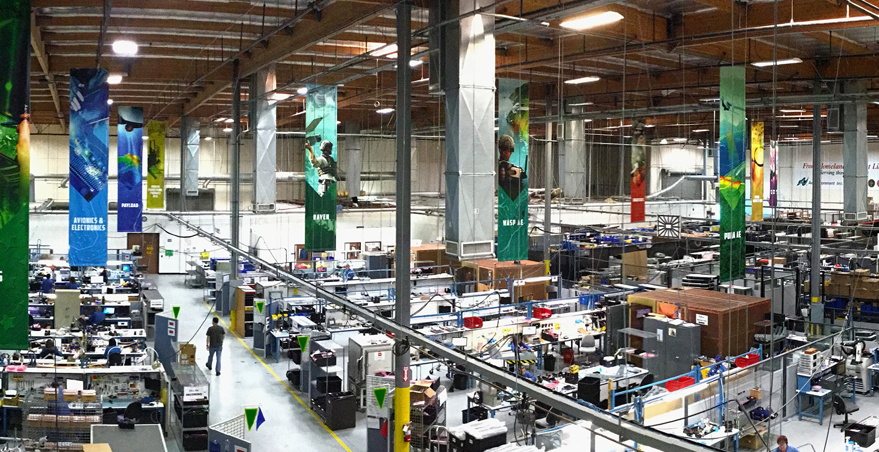
Inflection Point: Increasing the Global Military Prowess Gap
April 29, 2024
By Wahid Nawabi, AV’s Chairman, President and CEO
A recent report highlighted the disturbing fact that the militaries of Russia and China now follow closely behind the United States in terms of military prowess. The Global Firepower rankings were determined by a variety of factors, including but not limited to troop numbers, military equipment, and available resources. The bottom line is that our near-peer adversaries are trailing closely behind in their military capabilities, and if we do not put the necessary investment into further strengthening our defense industrial base, our national security will be put at risk. Rather than scaling back, the U.S. needs to invest in, develop, and field disruptive capabilities to increase the military prowess gap, and maintain its military superiority and global leadership.
Thanks to ongoing collaboration between industry, DoD and Congress, we feel confident in the direction the U.S. defense industry is heading – namely, embracing innovative new ideas and working together to overcome perceived and real obstacles to strengthening our national defense.
Recent statements by top Pentagon officials have demonstrated that autonomous systems are becoming a major part of military strategy for both the DoD and our allies. AeroVironment (AV) is the leader in autonomous systems and has delivered reliable, high technology readiness level (TRL), combat tested autonomous systems for over three decades. Our autonomous portfolio includes solutions ranging from stratospheric aircraft to submarine-launched loitering reconnaissance systems, to loitering munitions, to ground robots, and the command-and-control architecture to operate them all.
AV and companies like AV can be instrumental in widening the military prowess gap between the U.S. and our adversaries. Low inventories of fielded systems within the DoD put the U.S. at risk of falling behind in various theatres across the globe. Current and emerging conflicts such as in Ukraine, Israel and Taiwan demonstrate the necessity of reliable, fielded systems available to support from U.S. stockpiles to shore up defenses and maintain a tactical and operational edge on the battlefield. Delays in both contracting and funding are hampering efforts to meet the current threat environment.
Urgency is high across the globe and so is priority of our systems. In an effort to stay ahead of global threats, AV has invested heavily in increasing our production capacity, and we continue to build on this to surpass the current and future demand expectations of our customers.
AV has the manufacturing capacity to deliver distributed intelligent autonomous platforms for warfare at scale today, not tomorrow. We can produce tens of thousands of units at the level of rigor and performance the DoD and our allies have come to expect. We've delivered thousands of Switchblades in the last two years alone and believe that we're the only company that can produce loitering munitions at that rate today. Additionally, we're looking into new sites, facilities and expansion plans to go above and beyond current abilities.
Our book-to-build timeframe is very fast – a perfect example is when we delivered our first order of Puma UAS for the Ukraine war within 27 days. Our lead times are typically 90 days and we’re continuing to invest in our processes to continue this upward trend. Demand for our solutions is robust across the globe and we’re ready and qualified to rapidly deliver capabilities to warfighters.
By level loading our factories’ production throughout the year, we have achieved greater operational efficiencies while expanding throughput. AV has demonstrated market-leading manufacturing capacity for autonomous systems, and we continue to invest in facilities, people and processes to prepare for even greater demand in the future.
The world is at an inflection point, and the U.S. must be ready and willing to embrace the paradigm shift from traditional battlefield systems toward a distributed autonomous portfolio and affordable loitering munitions to increase operational efficiency. Partnering with companies that provide these disruptive technologies is instrumental in ensuring our troops are appropriately equipped and can be the key to unlocking battlefield superiority across the globe.
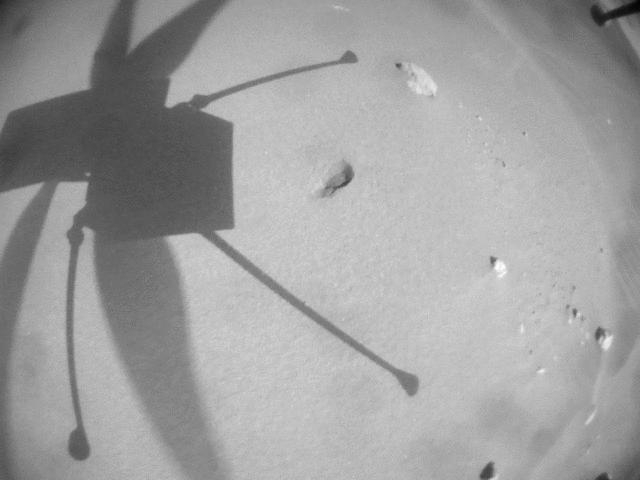
The Ongoing Triumph of Ingenuity
April 22, 2024
By William Pomerantz, AeroVironment
This is my love letter to Ingenuity.
I remember when I first heard about the concept of a small helicopter designed to catch a ride with a rover bound for the Martian surface. At the time, my wife worked as part of the 'Mars Mafia' at NASA Jet Propulsion Laboratory -- a wonderful job that meant she got to bring intriguing ideas and fascinating discoveries home from work regularly. My first reaction to the idea of a Martian drone was a quick sequence: No way! Could that even work? There's barely any atmosphere there. But could you imagine if it did work? No one has ever seen anything like that before. That would be incredible!
As I learned more about the idea, I marveled at the balance between the simplicity of the overall concept and the complexity of some of the engineering specifics required to make a helicopter fly on a planet where the atmospheric pressure at the surface is only 1% of what it is here on Earth (where it's already extremely challenging to make helicopters fly!).
While many people, myself included, were wondering what was possible, small teams at JPL and AeroVironment were creating what was possible. A quick, hardware-rich sprint by a team of incredible engineers, technicians, and project managers allowed the Ingenuity Mars helicopter project to be completed on schedule– words we too rarely get to say in the world of space exploration.
As the landing date for Perseverance and Ingenuity approached, I asked my JPL friends for their guesses as to how many times the helicopter would fly. By far the most common answer was that it would never make it off the ground in one piece. Another subset of people thought Ingenuity might fly once or twice.
After the nerve-wracking deployment of the helicopter from under the belly of Perseverance, followed by a few weeks of wiggling rotors and commissioning the vehicle, the world was treated to what you see in this GIF: the first aircraft to perform powered, controlled flight on a planet other than Earth.
This was a “Wright Brothers moment,” happening in our lifetimes, on another world. The impossible becoming possible. A new mode of peaceful exploration, coming online right before our eyes, in glorious full-color video.
Over the next three Earth years, Ingenuity would go on to surpass every expectation. From an initial target of five flights and 30 Martian days (sols), Ingenuity achieved 72 flights and about 1,000 sols. Ingenuity flew higher, faster, and further over more hazardous terrain than ever imagined. It returned first-of-its-kind images of the Perseverance rover, its backshell, and more. It gave us up-close images of Martian vistas that we're currently unable to explore by rover or with orbiters. The little helicopter that could survived a Martian winter with barely any damage. Every day, every flight, every image brought us precious new knowledge and expanded the horizons of humanity’s understanding of our closest planetary neighbor.
Along the way, some of the rover-centric teammates who had first seen Ingenuity as a distraction came to view the helicopter as an incredible new tool. The operations team is constantly faced with deciding between sending the rover to explore the most interesting territory and avoiding those same areas if the landscape might damage and strand the rover. It’s a tension that the JPL team is extraordinarily good at managing – but a tension nonetheless.
About sixty flights into Ingenuity’s planned five-flight mission, I had the great honor of joining AeroVironment to run the team responsible for our contributions to Ingenuity and the next generation of Mars helicopters. Ingenuity was still in excellent condition and was responding to every new challenge we gave it, making aerial exploration of Mars seem almost easy. But still, as we started what was effectively our twelfth victory lap after a race well run, we knew that every day Ingenuity phoned home was a gift.
As I got to know the team at AeroVironment and as I became reacquainted with the JPLers on the mission, one of the questions I asked was how people would like to see the mission end. We all wanted to see Ingenuity complete as many flights as possible; but I wanted to hear what the people who quite literally built Ingenuity thought. Should Ingenuity earn a quiet retirement in some picturesque location? Or should we push the edges of the envelope until at last we ask Ingenuity to do something it can’t manage, and see it fail in flight?
I received a range of strongly-held responses to my question, but the overwhelming majority of the Ingenuity team was aligned. They reinforced that this mission was designed as a technology demonstration, and the best way to honor the spirit of Ingenuity was to ensure that the vehicle kept teaching us new things about flight on Mars, right up to the end. If the choice ever became stand down or keep pushing, the team wanted to keep pushing.
And that’s exactly what happened. After more than seventy flights, we encountered a technical challenge that was simply beyond Ingenuity’s capabilities. The helicopter’s visual navigation system couldn’t distinguish the features of a very monotonous landscape well enough to consistently track them. Lacking that information, the vehicle essentially became confused about where it was and where it was going. As it descended, it may have begun to chase its own shadow.
At some point during the flight and landing, Ingenuity sustained significant damage to its rotor blades; and yet, somewhat miraculously, it survived that landing and came to rest upright on the Martian surface. Ingenuity is still alive and sending home data from its onboard systems – something it may continue to do for years to come. Perhaps if the Perseverance rover drives back by Valinor Hills Station (Ingenuity’s final airfield, named for Tolkien’s Undying Lands), Ingenuity will be able to phone home again and relay years’ worth of weather data to scientists on Earth. But unfortunately, it will never fly again.
Seventy-two flights. More than two hours of flying time. Over 1,000 sols after arriving on Mars. Eleven miles (17.7 kilometers) covered. All this from a helicopter that weathered rocket launch loads, Martian dust storms, and more without a single opportunity for in-person inspection or servicing – something you’d never expect of a helicopter here on Earth. Ingenuity gave us everything we asked for and more.
True to its spirit and its mission, even Ingenuity’s final flights have made us smarter. There’s more yet to learn, but from what I’ve seen, I believe the challenge that grounded Ingenuity will be relatively easy to overcome with future Mars helicopters, thanks to what we’ve now learned. Yes, Ingenuity reached a limit; but that limit can and will be conquered. Flight 72 marked an end, but not the end.
The true conclusion of the Ingenuity mission will come when its hard-earned lessons are next put into practice by another Mars helicopter – one that will be even more ingenuous than its predecessor, thanks to how much wiser we are after seventy-two flights.
AeroVironment has continued to invest funds and time into dreaming up new capabilities for future Mars helicopters. Engineers at AeroVironment, JPL, and NASA Ames are now thinking about helicopters and other aerial vehicles that could someday carry scientific instruments, fetch sample tubes, or explore difficult to access locations such as valleys and lava tubes.
Additionally, elsewhere in the world, others are following Ingenuity’s lead. In 2021, China announced its plans to fly a helicopter on Mars, and more recently, India has revealed more about its plan to fly a Martian helicopter with a variety of weather and atmospheric sensors within the next eight years. With a growing community of international space agencies interested in the exploration of the red planet, helicopters may become an affordable and attractive option for space discovery and diplomacy.
When the Ingenuity mission began, NASA’s leaders often compared it to the Wright Brothers 1903 Flyer – and indeed, Ingenuity carried a small piece of fabric from that historic aircraft to Mars. Now that the Martian equivalent of the Kitty Hawk flight has occurred, the successors to Orville and Wilbur at NASA JPL and AeroVironment are itching to embark on the next great endeavor that will forever change the future of planetary exploration. Planetary exploration helicopters have made their impact and are here to stay, and those in government, academia and industry who embrace and support the inclusion of these systems in future missions will surely reap the benefits.
Another novel forebearer of Ingenuity is Sojourner, the first successful Mars rover. Like Ingenuity, Sojourner was the lighter, smaller vehicle that hitched a ride with another mission to the red planet. Both programs had small budgets, but delivered huge results.
I believe the impactful legacy of Ingenuity will do for aerial mobility on Mars what Sojourner did for ground mobility: leave such an impactful legacy that at every future Martian launch window, and with every future call for proposals, this new form of exploration demonstrated by Ingenuity is considered a critical enabling technology for future discovery.
As Ingenuity’s flying campaign comes to an end, and as the era of aerial Mars exploration begins in earnest, my hat is off to the people who made this possible, including brilliant NASA and JPL colleagues like Bob Balaram, Charles Elachi, Mimi Aung, Robert Hogg, Bobby Braun, Theodore (Teddy) Tzanetos, Håvard Grip and more, and AeroVironment colleagues Matt Keennon, Benjamin Pipenberg, Sara Langberg, Jeremy Tyler, Joey Beckman, and more. Humanity’s best machines reflect the care, cleverness, and curiosity of their makers – and with Ingenuity, each of you has proven to be truly world-class.

Puma AE UAS – An ISR Platform That's Ideal for Counter–Trafficking
April 19, 2022
Charged with the challenge of tracking low-slung vessels over vast oceans, counter-trafficking forces often have to choose between stealth and search area. Now thanks to Puma AE UAS, they are discovering they can have both.

AeroVironment Continues to Support Local Schools Through its IMPACT! Corporate Social Responsibility Program
January 06, 2022
AeroVironment continues to make a positive impact in the Ventura County community through its Corporate Social Responsibility Program. In 2021, AeroVironment supported the Simi Valley Education Foundation in funding 18 STEM-related enhancement grants to advance school projects in science, technology, education and math.

AeroVironment Participates in NATO REP(MUS) 21 - Team demonstrates latest capabilities in maritime drone technology
November 01, 2021
In mid-September 2021, AeroVironment participated in a major NATO-sponsored exercise called REP(MUS) 21, which stands for Robotic Experimentation and Prototyping Augmented by Maritime Unmanned Systems, 2021. The event took place at the Portuguese Navy Centre for Operational Experimentation in Troia, Portugal, and included the navies from 13 active participating nations and three observing nations. REP(MUS) 21 was jointly organized by the Portuguese Navy, the University of Porto, NATO’s Centre for Maritime Research and Experimentation and the NATO Unmanned Systems Initiative. The objective was to enhance NATO members’ maritime capabilities.

AeroVironment Continues to Support Local Communities Through its IMPACT! Corporate Social Responsibility Program
October 14, 2021
Did you know that the Ingenuity Mars Helicopter has a terrestrial sibling? It’s true — meet, Terry Earth Copter — specifically designed for research and educational purposes.
Recently, the AeroVironment Mars team embarked on an opportunity to connect with various YMCA summer camp groups in the Simi Valley, CA area as part of their STEAM program.

Unmanned Ground Vehicles – Handling dangerous tasks from a safe distance
August 23, 2021
Unmanned ground vehicles (UGVs) have been used in military settings for over a century. In 1915, French engineers developed the “Torpille Terrestre” (Land Torpedo) — a UGV loaded with explosives meant to breach enemy lines. In the 1930s, the Soviets began using UGVs based on the T-18 and T-26 tanks and were dubbed “Teletanks.” The Teletanks were controlled remotely from another tank about a mile away and were deployed in the Winter War against Finland in 1940. The UGV had a humble beginning as little more than a single-use detonation device, but today these vehicles feature state-of-the-art capabilities that work to protect and preserve lives.

Soaring to New Heights - Innovation drives the creation of high-altitude aircraft and stratospheric “cell towers”
May 05, 2021
When it comes to flying high, AeroVironment has led the way in sustained solar-powered, high-altitude flight with projects dating back more than 40 years. Building on its pioneering innovations — Gossamer Condor, Solar Challenger, Pathfinder Plus, and Helios — AeroVironment advanced these earlier technologies to develop a solar-powered, high-altitude platform station (HAPS) named Sunglider™.
“These earlier innovations made significant contributions to the current HAPS aircraft,” said Bob Curtin, HAPS business development director. “I think it’s reasonable to say that the development of today’s HAPS aircraft started with the Gossamer Condor in 1977.”

Beyond the Battlefield - Deploying UAS for Environmental and Scientific Research
April 06, 2021
Could a drone that is used to scout for enemy activity on the battlefield also help count endangered seals in Alaska? What about relaying communications from a remote area to an emergency response center? For the past 50 years, our innovative engineers have been asking these type of questions to provide our customers with new ways of achieving their goals. The same features and capabilities AeroVironment's unmanned aircraft systems provide to troops on the front line could address a host of missions beyond the military.

AeroVironment – ahead of the curve, helping to pave the way for the modern EV
March 10, 2021
AeroVironment has always been powered by great thinkers and doers, constantly experimenting with new ideas that help customers do more and offering innovative firsts and never-seen-before solutions. These innovators have learned over time that being at the forefront of technology can be both daunting and rewarding, and the adoption of transformative solutions can take time, but in the end, they come to life.

Look, Up in the Sky…It’s a Bird…It’s a Plane… It’s a…Nano Hummingbird
February 23, 2021
The Nano Hummingbird proved to be a first-of-its-kind innovation. The micro air vehicle was the first flapping-wing, nano unmanned air vehicle (UAV) with tai-axis control, which enabled it to hover and fly sideways, backward and forward, as well as rotate clockwise and counter clockwise and counterclockwise - all by remote control.
Designed and developed by AeroVironment's MacCready Works Advanced Solutions team, the Nano Hummingbird was a unique project that satisfied a specific customer requirement.

Sunraycer - Illuminating the Path toward the Modern Electric Vehicle
January 25, 2021
Solar technology isn't a recent discovery. Its history dates back to the seventh century B.C. when a magnifying glass was used to concentrate the sun's rays to make fire.
Fast forward to 1839, French physicist Edmond Becquerel discovered the photovoltaic effect (generating voltage and electric current upon exposure to light) while experimenting with a cell made of metal electrodes in a conducting solution. He saw that the cell produced more electricity when it was exposed to light. Many physicists and scientists contributed to the awareness, introduction and proliferation of solar energy technology, including AeroVironment founder Dr. Paul MacCready, Jr.

AeroVironment continues to bolster local communities through its IMPACT! Corporate Social Responsibility Program.
January 11, 2021
AeroVironment's Huntsville office recently took action to participate in the company's IMPACT! Program by getting involved in several local activities.
AeroVironment donated $2500 to the 2020 Still Serving Veterans (SSV) Golf Tournament. The annual event took place Friday, Oct. 9, in Cullman, Ala. All proceeds went to support veterans.

Switchblade: From Gun-Launched UAV to Precision Strike Loitering Missile System
November 24, 2020
Imagine a frontline defense that could neutralize your enemy within seconds and save your life and the lives of those around you. The movie "The Hurt Locker" features a scene in which the protagonists are pinned down overnight by a single sniper. Every time a member of their group peeks over the embankment to fix the location of the sniper, they are shot. Now, imagine if the team possessed a tube-launched air vehicle that they could launch at will and use to find, fix and neutralize the sniper without placing anyone in harm's way. That "imaginary" frontline defense solution is real, and it's called Switchblade.
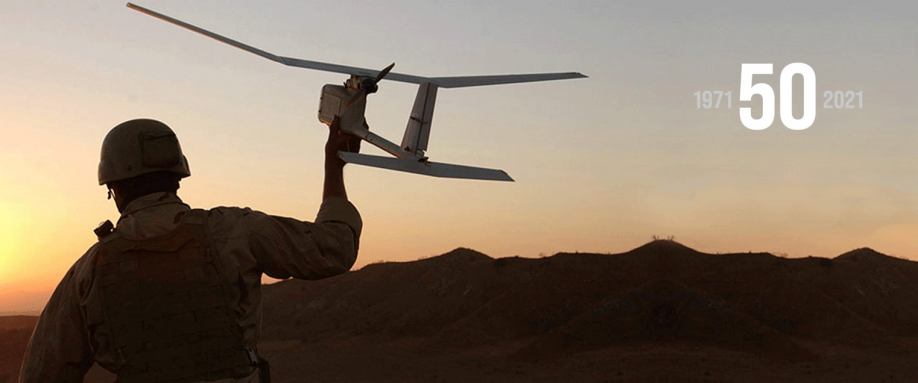
How AeroVironment Became A World Leader In The Small UAS Market
September 15, 2020
"For AeroVironment, success came as a result of four core elements: innovation, simplicity/elegance of design, reliability, and customer collaboration," said Scott Newbern, AeroVironment's chief technology officer. Newbern, who has been with the company since 1997, identified these core elements as the foundation that launched AeroVironment into the global, small, unmanned aircraft systems (UAS) business.
According to Newbern, the innovative spirit has been a distinct characteristic among AeroVironment employees since the company's inception. "Back in the early days, many employees were aviation enthusiasts in one way or another," he stated, "and some were world champions competing in aircraft modeling events around the world.
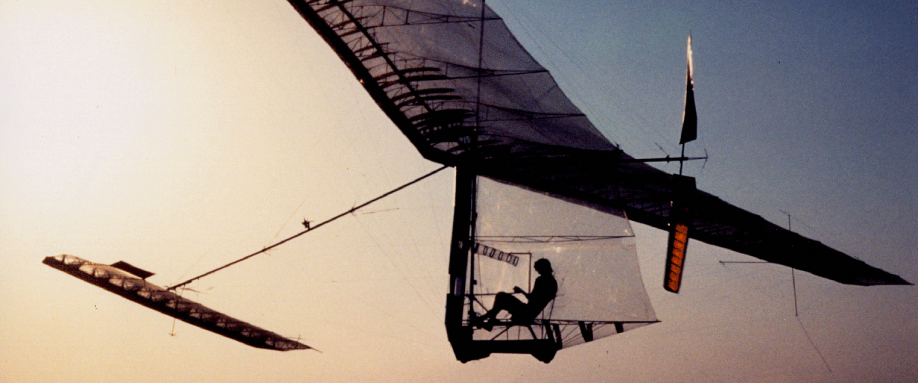
Gossamer Condor - The First Of Its Kind
August 19, 2020
A human-powered airplane built by Dr. Paul MacCready, Jr.
Dr. Paul MacCready, Jr., had an unorthodox approach to aviation design, one that paid high dividends throughout his lifetime. His philosophy was to design and build for quick iteration, and he is quoted as saying, “Find a faster way to fail, recover, and try again.” That methodology certainly worked for the design of the Gossamer Condor, the first successful human-powered aircraft.
In 1959, British industrialist Henry Kremer put out a challenge to build a human-powered airplane and attached a substantial monetary prize for the winner. For 18 years, nobody could do it. Dr. MacCready was up for the challenge. Only six months after attempting his aircraft design, a pilot successfully flew the Gossamer Condor. The difference? While others needed a year’s worth of effort for each test flight, Dr. MacCready created a plane that he could fly, fix, and fly again in just a few hours.
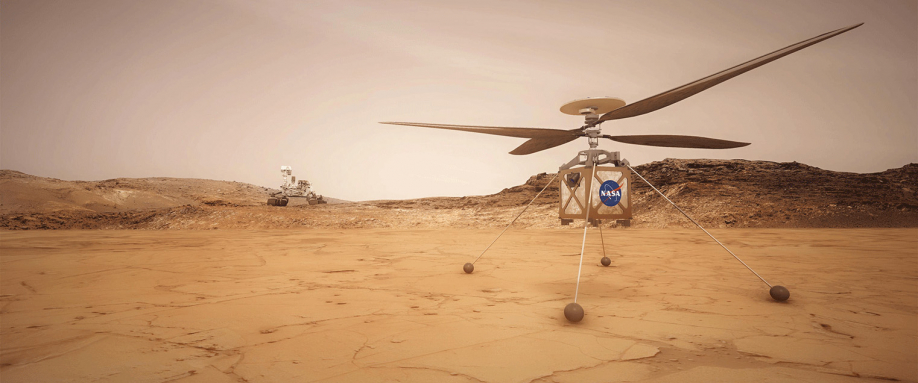
AeroVironment Team Collaborates with NASA/JPL for Mars Helicopter Launch in July
July 27, 2020
It wasn't enough for AeroVironment engineers to design drones for use on Earth - they had their sights set on something even bigger.
Since 2013, AeroVironment's team of innovative engineers from our MacCready Works laboratory has been working with NASA/JPL to design and develop the first Mars drone - a helicopter that will be carried by the Mars 2020 rover. Its name is Ingenuity. The rover was designed and built by NASA/JPL and was recently named Perseverance, or Percy for short. Percy is scheduled to launch in July 2020 and arrive on Mars in early 2021.
The Mars helicopter is a small, autonomous rotorcraft that weighs 4 lbs. (1.8 kg). Its purpose is to demonstrate the viability of aerial robots for planetary exploration.

AeroVironment Helps the Community While Protecting the Environment
June 29, 2020
Are you familiar with e-waste? Can you think of how e-waste is a part of your life? E-waste, or electronic waste, is the popular term loosely used for electronic products nearing the end of their "useful life." Common e-waste products include TVs, VCRs, printers, computers, monitors, cell phones, and copy machines.
Rapid advances in technology and an expanding demand for new features accelerate the obsolescence of "old" electronics, increasing the volume of e-waste. Constant turnover can result in improper disposal, which leaves tons of salvageable materials such as precious metals, plastics, and glass, as well as hazardous chemicals, in landfills.
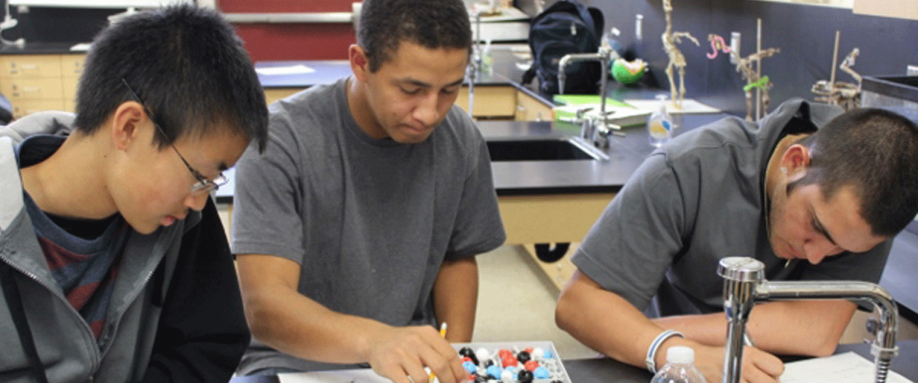
AeroVironment makes an impact on local schools through its Corporate Social Responsibility Program
February 18, 2020
AeroVironment makes an impact on local schools through its Corporate Social Responsibility Program
As part of its Corporate Social Responsibility Program, AeroVironment continued its commitment to making an impact in the community in 2019 by earmarking money for the Simi Valley Education Foundation's (SVEF) annual Enhancements Grant Program. AeroVironment chose to fund grants specifically for Science, Technology, Engineering, and Mathematics (STEM)-related projects throughout the Simi Valley Unified School District. Money was awarded based on grant requests written by teachers for enhancement of education in their classrooms. Distributed funds were presented in person at each school for immediate use.
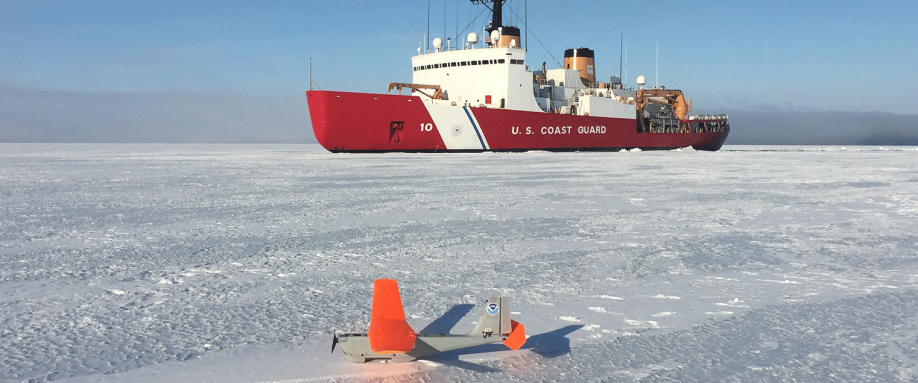
U.S. Coast Guard Deploys Puma™ AE during Operation Deep Freeze
February 04, 2020
AeroVironment's Puma AE Makes Historical Debut to Assist with Navigation through Icy Waters
Puma AE made history in 2016! Never before had an unmanned aircraft system been used by the U.S. Coast Guard Cutter Polar Star for its annual Deep Freeze mission to Antarctica's McMurdo Sound. Every year, this heavy icebreaker travels to the Sound to open up the shipping lanes needed to resupply the National Science Foundation's McMurdo Station and other facilities on Ross Island.
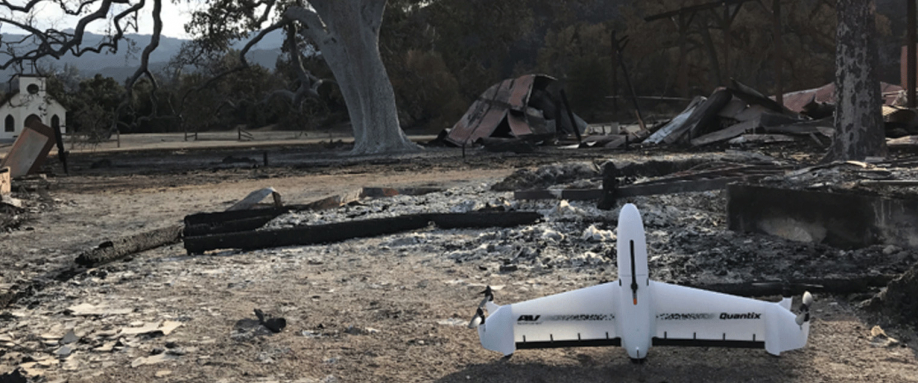
Learn How the National Park Service Acquired Actionable Data Using Quantix UAS
January 20, 2020
How the National Park Service Acquired Actionable Data Using Quantix UAS
It's been over a year since the devastating Woolsey Fire burned more than 96,000 acres across Los Angeles and Ventura Counties. The fire destroyed 88% of National Park Service land within the Santa Monica Mountains Recreation Area and set in motion a need for an environmental impact study to assess fire damage in key areas of the park. The National Park Service reached out to AeroVironment for assistance, and the flight operation's team began flying Quantix as soon as the park service clearance was obtained.
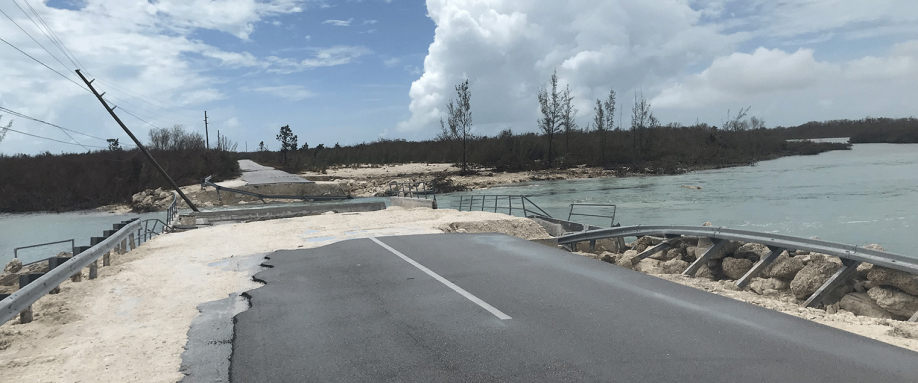
Bahamas Relief Operation
December 20, 2019
AeroVironment Team Supported Hurricane Dorian Aid Efforts
"The Damage was unimaginable." said AeroVironment Flight Operations Manager Eric Thompson as he surveilled the destruction from Hurrican Dorian on Abaco - a small group of islands in the northern Bahamas. "When we arrived, we could see that the hurricane had destroyed everything in its path."
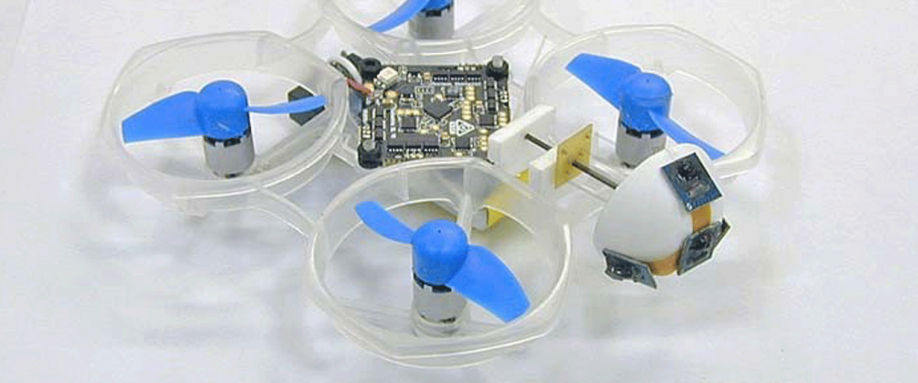
Can Insects Provide the “Know-How” for Advanced Artificial Intelligence?
December 02, 2019
The Defense Advanced Research Projects Agency (DARPA) has set out to find ways to build artificial intelligence (AI) systems that are as efficient at computing and processing as the brain of small flying insects. DARPA wants to explore cutting-edge technology that involves the study of insect brains and their ability to react to the world around them with minimal computation.